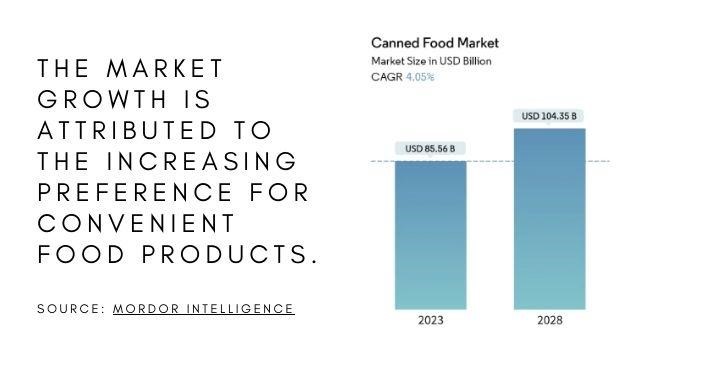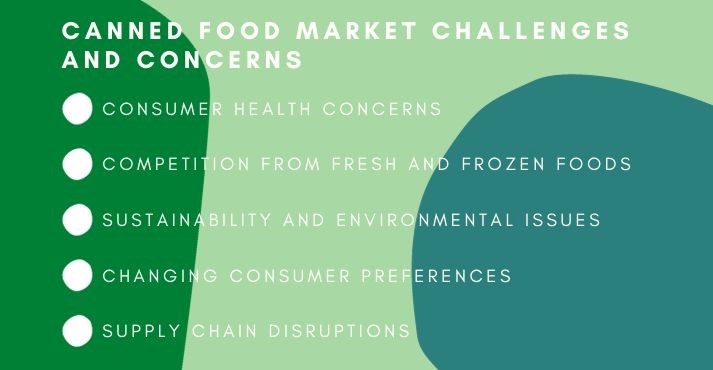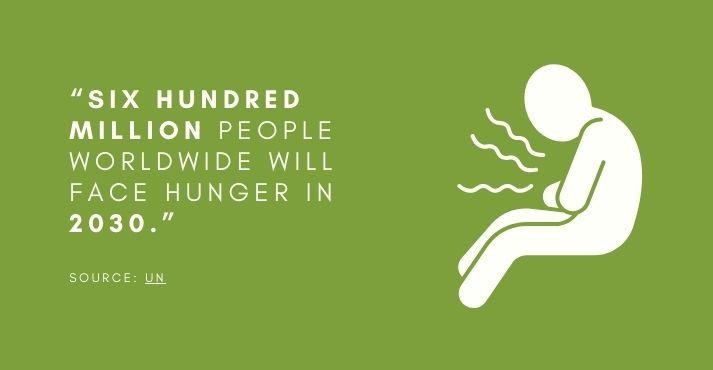The canned food market is poised to grow anytime, anywhere, and anything.
Driven by the drastic changes in consumer preferences, ready-to-eat or drink products, and value chains, canned food holds a prominent position in the Food and Beverage sector. The global canned food market is expected to reach US$118 billion by the end of 2023.
The consumers of the canned food industry are willing to spend more owing to their fast-paced lifestyles and the increase in the working population.
Despite the driving factors, food contamination, growing health awareness, and focus on sustainable packaging are some of the critical challenges the canned food industry faces.
Let’s delve into the canned food market analysis by discussing the following aspects.
- Current State of the Canned Food Market
- Types of Canned Foods
- Impact of Technology on Canned Food
- Market Challenges and Concerns
- Future Outlook of the Canned Food Market
Current State of the Canned Food Market

The canned food market is estimated at USD 85.56 billion in 2023 and is expected to reach USD 104.35 billion by 2028, growing at a CAGR of 4.05% during the forecast period (2023-2028).
The most prominent canned food companies in the world are the following:
- Danish Crown
- Bolton Group
- Goya Foods
- Grupo Calvo
- Ayam Brand
- Rhodes Food Group
- Campbell Soup
- Nestle
- Conagra Brands
- Bumble Bee
- Dongwon Industries
- Del Monte Foods
- Kraft Heinz
- Bonduelle
- Dole Food
- Kangfa
- B&G Food
- Hormel Foods
- General Mills
- Shanghaimaling
In line with this, these top companies’ variations, premiumization, and innovation in canned food positively influence the market.
As the metrics in the Food and Beverage industry evolve, companies focus on expanding their distribution network and developing healthy options for consumers seeking nutritional or vegan food.
Types of Canned Foods
Canned foods are a staple for every pantry. They can add nutrients to your meals and are convenient for easy cooking. Listed below are the different types of canned foods:
Canned Fruits
The canned fruits market size is expected to grow from USD 10.46 billion in 2023 to USD 12.93 billion by 2028, at a CAGR of 4.34% during the forecast period (2023-2028), such as pineapples, pears, Mandarin oranges, pink grapefruit, and fruit cocktails.
The primary factors driving the canned fruits market growth are developments that advance canning technology, private-label manufacturers, Nutri-score labels on cans, healthier food choices, and long shelf life.
Canned Vegetables
The canned vegetable market is expected to reach US$ 30.62 Billion by 2030 at a 3.84% CAGR. Such as corn, green beans, mushrooms, carrots, beets, asparagus, and tomatoes
The market for canned vegetables will expand due to varieties, novel products, consumer dietary demands, and more people going to work and spending less time cooking.
Canned Grains
The canned grains market is worth US$ 108.18 billion in 2023 and is expected to grow at a CAGR of 3.97% by 2028, such as pasta, noodle soup, and barley soup.
The canned grains market is driven by factors such as the capability to be stored for long periods, accessible transportation, processing of different foods, nutritional value, active lifestyle, and convenience.
Canned Dairy
Canned dairy products, such as evaporated, flavored, and condensed, are created to deliver everyday comfort, nutrition, and delight.
While the dairy industry grapples with the sudden changes in the market, such as demand for plant-based milk, sales of evaporated canned milk are on the rise, owing to its texture and different package sizes.
Canned Protein
The protein market continues to present substantial growth opportunities for the food industry and is set to grow to over 114 billion U.S. dollars by 2030.
The demand for canned protein products such as tuna, shrimp, salmon, chicken, beans, chickpeas, and lentils is growing due to increasing work culture, changing consumer preferences, ready-to-eat meals, and nutrition concerns for a protein-rich diet.
Overall, food importers and exporters are witnessing an increasing demand for canned food worldwide.
Impact of Technology on Canned Food
The Food and Beverage sector and technology have a symbiotic relationship. As food tech continues to evolve, canned food manufacturers increasingly adopt high-performance technologies that allow cost reduction, energy efficiency, and longer shelf life.
Automation and robotics streamline production processes, improve food preservation and safety, and ensure quality and taste. IoT sensors are employed for real-time inventory and product quality monitoring, minimizing waste and ensuring freshness.
High-pressure processing and Modified atmosphere packaging (MAP) innovations are being used to preserve foods while retaining nutrient taste and to extend shelf life. Innovative packaging with QR codes and freshness indicators provides real-time information.
Also, ultraviolet (UV-C) and ultrasonic radiation are used to preserve canned foods. UV-C lights are used to sanitize water used in food processing and production and help prevent the growth of harmful bacteria.
Blockchain technology has become integral to the canning industry to enhance transparency and traceability. It allows companies to track raw materials, production, and distribution processes throughout their supply chain to ensure quality and also build credibility among consumers.
Innovation in sustainable food packaging in the canned food industry is increasing, such as biodegradable or recyclable options to reduce environmental impact.
Market Challenges and Concerns

Fresh versus frozen or canned isn’t a “fixed pie” or win/lose competition. Each category generates sales in one way or another. Even amid fresh’s success, canned food products are making inroads with consumers.
According to the USDA’s Dietary Guidelines, adults should eat at least 2 servings of fruit each day. And canned fruit can be just as healthy (if not more) than its fresh counterpart.
However, it is recommended to read labels and choose cans wisely as some of them can contain high levels of sodium, heavy syrup coats, and contaminated due to improper canning.
However, when we gain insights from another study conducted by Deloitte, fresh food is a seeming obsession of consumers and industry alike.
According to the survey conducted by Deloitte, nine in 10 say fresh food makes them happy, and 83% think it minimizes the risk of chronic health conditions and disease.
Due to a mixed approach and choices, the canned food market faces specific challenges and concerns. Let’s look into each of these.
Consumer Health Concerns
The canned food market faces increasing scrutiny for health-related concerns as consumers seek fresh alternatives. Canned food products often contain high sodium levels, preservatives, and BPA linings, impacting consumer purchase decisions.
Competition from Fresh and Frozen Foods
Canned foods compete with fresh and frozen foods, perceived as more nutritious and less processed, leading to challenges in maintaining market share.
Sustainability and Environmental Issues
When food manufacturers use cans, much waste is generated from metal cans and energy-intensive manufacturing processes. As consumers gain sustainability awareness and become environmentally conscious, canned food manufacturers must adopt eco-friendly practices, such as recyclable packaging, and focus on reducing energy consumption.
Changing Consumer Preferences
The canned food manufacturers are challenged to evolve their products with changing consumer tastes and dietary trends, such as veganism, gluten-free, and organic preferences.
Supply Chain Disruptions
Since the pandemic, the supply chain worldwide has been disrupted, and delays are in line. Although the industries are recovering from the disruptions, the canned food industry requires enhanced resilience and contingency planning.
However, the future of fresh is changing – consumers are increasingly becoming aware of their needs, preferences, and the demand to meet these changes, and the canned food market is increasingly introducing novel products, adopting food packaging technology, and addressing consumers’ health concerns.
Future Outlook of the Canned Food Market

According to the UN, more than 600 million people worldwide will face hunger in 2030. The global issue of hunger and food insecurity has shown an alarming increase since 2015, and the pandemic, conflict, climate change, and deepening inequalities have further exacerbated the issue.
Food distributors recognize that an increasingly denser population and urbanization continue to create an even more significant demand for ready-to-eat, nutritious food.
The world loses an astounding quantity of food yearly, as 1.3 billion tons of food suitable for human consumption and 1.6 billion tons of so-called “primary product equivalents” are lost or wasted.
Also, food waste has a direct economic consequence of $750 billion yearly. This staggering statistic underscores a troubling inefficiency in our food distribution system.
As a solution, canning food has emerged as a viable solution to combat this issue. By canning, we extend the shelf life of perishable goods, preventing spoilage and providing nutritious meals to those who require them.
Canned foods are not vulnerable to extended supply chains to reach consumers and can ensure more people have access to nourishing sustenance.
Moreover, export opportunities have expanded, leading to a broader market reach for established and emerging players. Navigating international regulations and consumer preferences will be vital for companies seeking to capitalize on this trend.
Frequently Asked Questions (FAQs)
Which is the fastest-growing region in the canned food market?
The Asia Pacific is the fastest-growing region in the canned food market. The canned food market in the Asia Pacific is estimated to grow at a CAGR of 4.25% to reach US$ 23. 8 billion by 2026.
Who are the key players/companies in the global canned food market?
The key players/companies in the global canned food market are:
- Danish Crown
- Bolton Group
- Goya Foods
- Grupo Calvo
- Ayam Brand
- Rhodes Food Group
- Campbell Soup
- Nestle
- Conagra Brands
- Bumble Bee
- Dongwon Industries
- Del Monte Foods
- Kraft Heinz
- Bonduelle
- Dole Food
- Kangfa
- B&G Food
- Hormel Foods
- General Mills
- Shanghaimaling
Closing Thoughts
The canned food market analysis reveals that the market continues to display resilience and adaptability. Significant trends and considerations are shaping the canned food industry.
Despite ongoing challenges, such as supply chain disruptions and shifting consumer preferences, the canned food market remains robust.
By staying attuned to consumer preferences, embracing innovation, fostering sustainability, and leveraging technology, businesses within this sector can position themselves for long-term success.





























